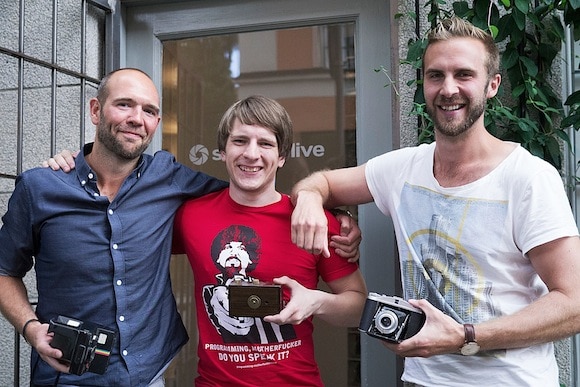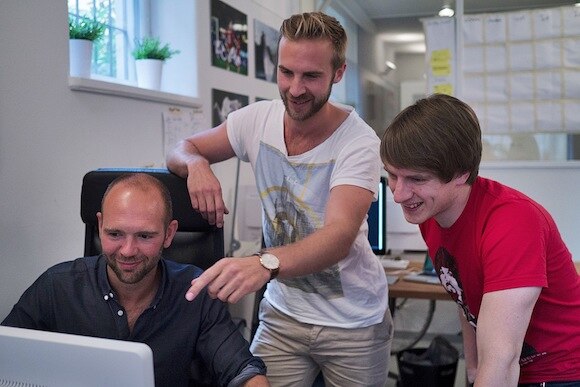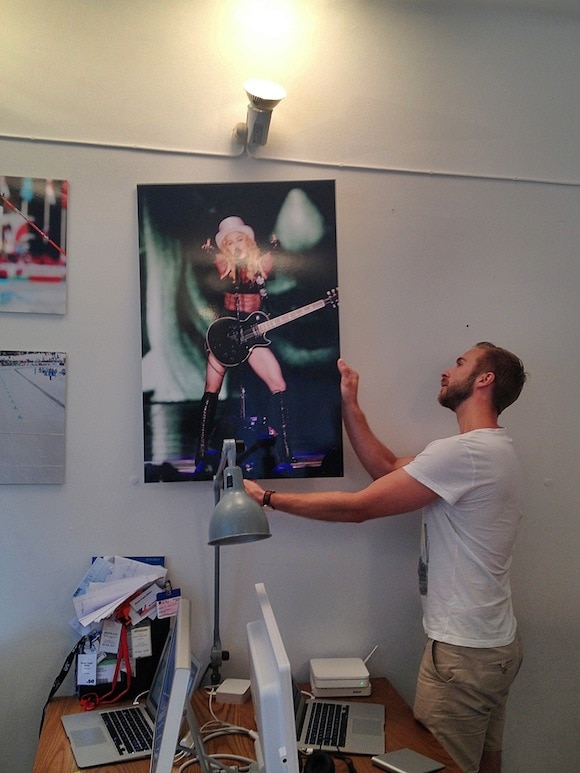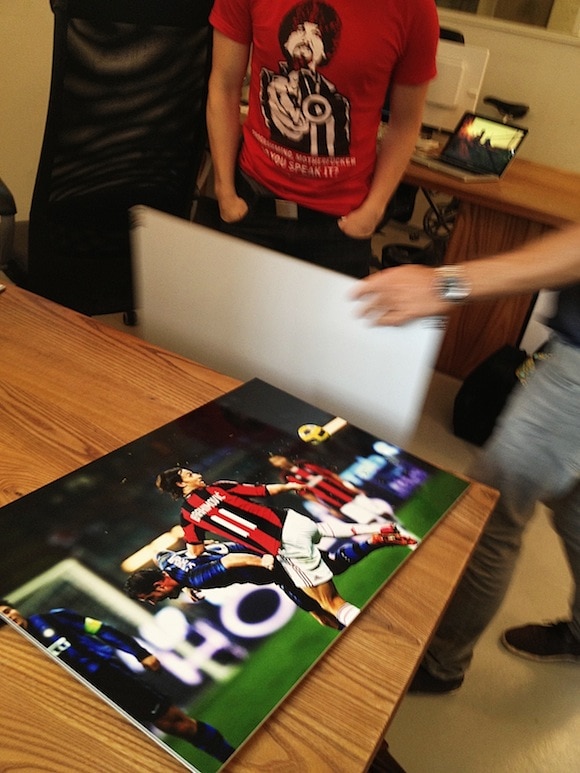Shootitlive was born with a demo in a conference room at one of the biggest daily newspapers in Sweden. The demo was a hack hosted on one of the co-founder’s computers at home. A Shootitlive widget was inserted into a copy of the daily’s homepage. When photos started to appear on the fake homepage, merely seconds after the camera had captured the photo, the deal was in effect done.
That’s how Shootitlive got started and how it managed to sign up many of the biggest newspapers in Northern Europe as customers. On the bleeding edge of news photography and video, Shootitlive is now poised for further international expansion.
“We took it all the way”
As we learned last year, in the landscape of online video, Shootitlive has carved out a niche. It helps media outlets such as newspapers deliver video and photos quickly to their audiences. The photographer in the field live publish photos and video clips from camera to web in a couple of seconds

The foundation of Shootitlive lies firmly in the direct and personal experience of the founders Eivind and Martin in the photo and publishing industries.
- Eivind Vogel-Rödin worked at a daily newspaper as a press photographer when the industry started to really push for web and digital in the mid-00s.
- Martin Levy had wide-ranging experience including web and TV.
- Joining the team later was Emil Stenqvist, CTO of Shootitlive and one of the main developers.
In the fall of 2008, when the demo took place, real-time reporting from the field was fast becoming popular even among newspapers, and the need to get photos to editors quickly was pressing.
Although the hardware to support a service like Shootitlive already existed at the time, the service to tie it all together did not.
“We took it all the way,” Eivind says.
Shootitlive’s solution went from the camera all the way into the photo desk at a newspaper, all the way to the editor and a live web page. This complete solution included offering a kit with a professional DSLR, transmitter, 3G router, and Shootitlive subscription.
Shootitlive worked with Canon to put this together because it was the most forward thinking camera company at the time, says Martin.
The first big success effectively shut down an entire hosting provider
After that first demo at the newspaper, the Shootitlive system was developed at a brisk pace. The initial functionality wasn’t that much of a problem, but achieving scalability were.

During the World Cup qualifier between Sweden and Portugal in 2008, Eivind was a photographer for a large newspaper, and he used Shootitlive. This was just supposed to be a demonstration of what the system could do and the paper had said it would only publish the Shootitlive player in an article on its site. But a few minutes into the game the editors republished the player on the paper’s landing page.
That came as quite a surprise, the two co-founders say almost in unison.
Martin explains that, in those early days of Shootitlive, the service was hosted on a VPS in Sweden. “The company where the VPS was hosted called us that night and told us that they were completely down,” says Martin. That meant that the sites of all other customers for that hosting company were down because the Shootitlive server was taking up so much bandwidth. The hosting company threatened to shut Shootitlive down, which obviously wouldn’t have been good as it was driving the coverage of the qualifying match. With the help of the newspaper and quite a bit of understanding from the hosting company the situation was resolved, Martin says. As a result, Shootitlive managed to stay up during the entire game.
“That was an early reminder that scaling would be an important issue for us going forward,” Martin says.
As it turns out, an early CDN (Content Delivery Network) that supported mirroring of files was the saving grace for Shootitlive. “CDNs were not a big thing back then, not sure we had even heard of one. That was at the end of 2008, I think,” says Martin.

As Shootitlive gained more customers, the same thing that happened with the World Cup match happened with major newspapers across Northern Europe. What was supposed to be a small and limited test turned out to be full-out deployments with multiple photographers live publishing photos and videos straight to their landing pages.
“We realized that everyone loved our system,” says Eivind.
Usage patterns like a roller coaster
For Shootitlive, the big challenge today when it comes to the technology, Emil says, is the usage patterns of its customers. The basic functionality is to source photos and video, get them into the system, and make them available to editors and photographers waiting to publish them on websites. But when one day it may be 1,500 photos and videos and another day ten times that or more, the usage patterns “look like a roller coaster,” says Emil.
For example, during the royal wedding in Sweden in 2010, the Shootitlive player was on top on the landing page at 25 of Northern Europe’s biggest sites. Over just a few days, Shootitlive:
- Sent out over 60TB of data to its customers.
- Displayed more than 100,000,000 photos to visitors.
- Altogether 1.7 billion requests.
Despite heavy usage during those few days of the royal wedding and many other events, Shootitlive has managed to keep its system running and scaling seamlessly when needed. Emil attributes this to its cloud-based architecture, running on Amazon AWS, and autoscaling. In practice, Emil says, they don’t have to do anything to kick off another server or more, that’s all handled automatically.

When it comes to what technology Shootitlive is developed with, Emil says, “we’re 95% Python, and we’re very happy.” When probed about why they have selected Python he says that there’s a great community, and quite simply, “we trust it.” The whole team seems to agree that Python has worked very well for them and that they have no plans to change.
Making sure it all runs
With such high demands on its infrastructure, it’s clear that Shootitlive has to keep a close eye on how things work, and Pingdom’s website monitoring is one tool it uses. “That we can see what goes down almost at the moment it goes down is golden for us,” says Emil.
“With Pingdom, we can measure so many different things, like customer experience, how fast does pages load for customers right now, and more,” Emil says. “Plus we can get alerts in many different ways like SMS, Twitter, and the apps.
Shootitlive is also using Pingdom Real User Monitoring (RUM) to a great extent, a tool that lets them keep an eye on how their customers experience the company’s services. Martin says that they use RUM for sites they build and run for customers, such as bildspel.aftonbladet.se, which is completely built and operated by Shootitlive for the newspaper.
“[RUM] gives us great insights into how people experience those sites,” Martin says. “It’s important to be able to see for what percentage of users does it take longer than x seconds to load the page, what is the average and mean load times, how does the site load in different browsers.”
The next step: integration and international expansion
When it comes to future plans, what the guys emphasize is integration with other services in general and social media in particular. Shootitlive already integrates with photos and video from Instagram.
That type of integration is also how Shootitlive plans to expand internationally. Now that its core technology has been developed and battle-tested at big events, the guys will put the focus on tying that technology in with other services.

Shootitlive has matured to the point where they can now market the service to any newspaper or other newsroom around the world. “There’s still a lot of change in the industry, but web first or web and print in one organization is something that is now the accepted way of working and we fit right in there,” says Martin.
The demo paid off
Eivind, Emil, and Martin speak with obvious passion about what they’ve accomplished, and so they should. From the kick-ass demo that set it all in motion to the recent developments with live coverage of a royal wedding and international expansion. Shootitlive has come far in a short period of time.
After spending a few hours with them, we can say with confidence that we’ve only seen the beginning of Shootitlive. We certainly look forward to following the young company to see what the future holds for it.
Do you have an interesting story to tell? Let us know in the comments below or via Twitter.



























